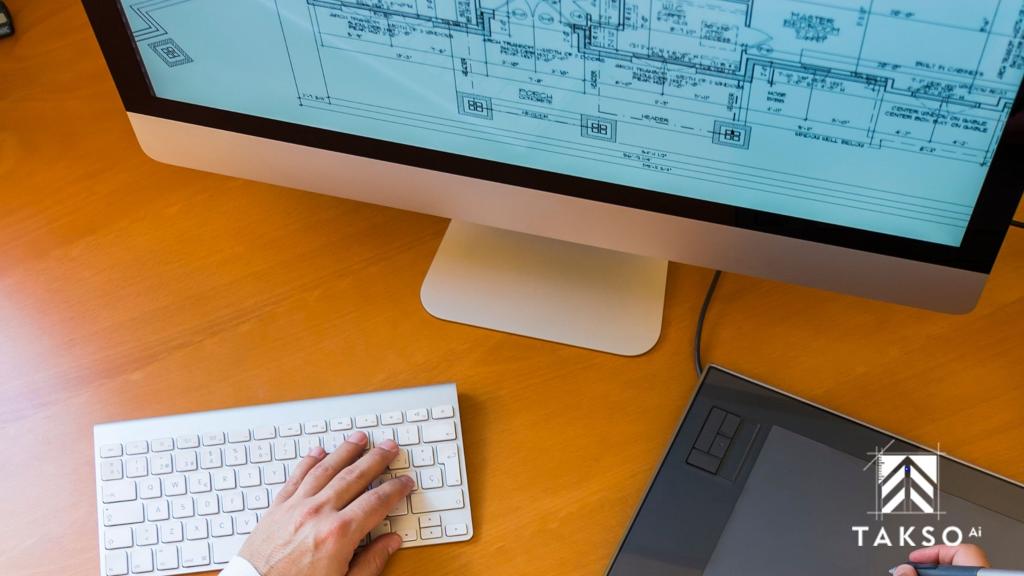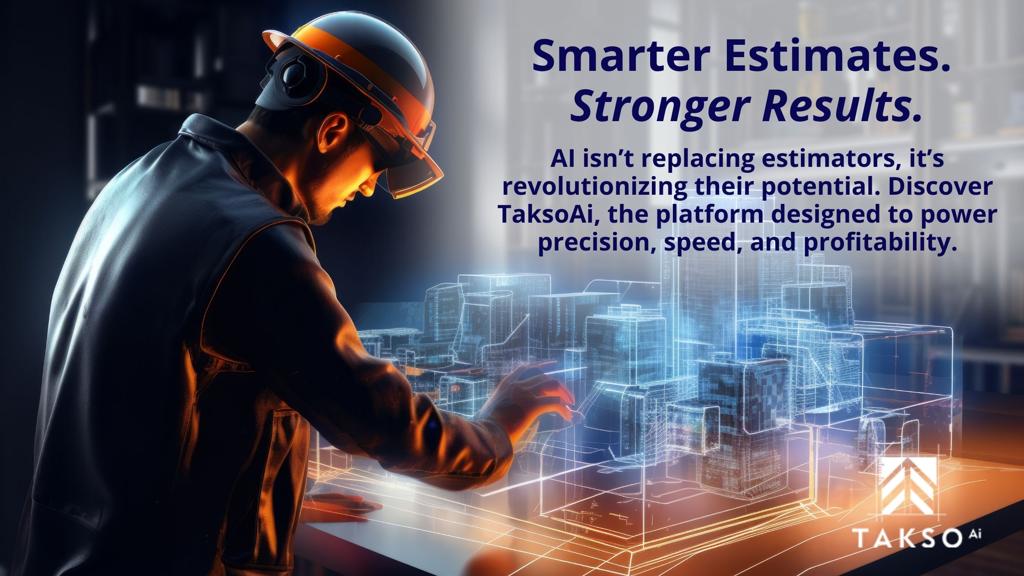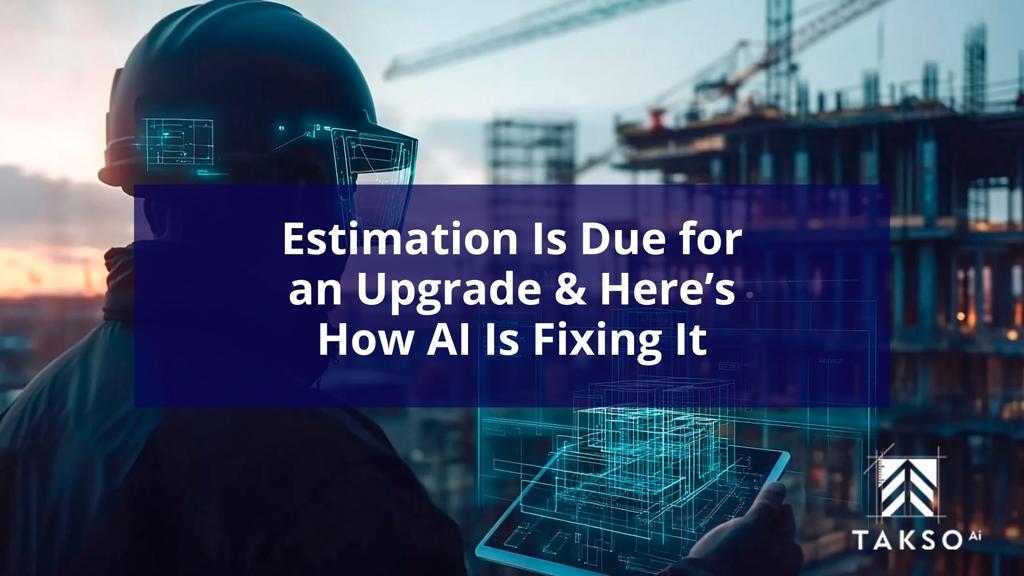Construction technology continues to evolve rapidly, from robotics to digital twins and advanced design software. Yet one critical workflow that has resisted progress is estimation.
Most MEP contractors still rely on manual takeoffs that involve opening PDFs, tracing duct runs, counting fixtures, and building spreadsheets line by line. It is repetitive, time-consuming, and error-prone. While design coordination and scheduling tools have advanced, estimating remains slow, manual, and disconnected.
The consequences are measurable. Skilled estimators lose valuable hours to low-value tasks, projects face margin pressure, and firms struggle to scale bidding capacity. Artificial intelligence is changing that reality.
AI-driven estimating tools combine computer vision, pattern recognition, and data analytics to transform how contractors quantify drawings and prepare bids. TaksoAi is leading that transformation with purpose-built technology designed for MEP contractors who need faster, more accurate takeoffs that do not rely on complex modeling or metadata.
The Problem with Traditional Estimating
Manual estimating may feel reliable, but it limits efficiency, accuracy, and profitability.
High Overhead Costs
Estimation can consume up to fifteen percent of a company’s overhead, yet only a fraction of bids succeed. The rest represents lost time and resources, especially when teams must rework drawings or correct miscounts. Each unproductive cycle adds cost and drains capacity for innovation.
Accuracy and Profit Risk
Tight deadlines leave little room for review. A single missed pipe or fitting can trigger delays and cost overruns, directly cutting into profit margins and client confidence. The more projects in play, the higher the risk of small errors compounding into significant losses.
Resource Bottlenecks
Experienced estimators spend much of their time on repetitive data entry instead of analysis and strategy. As workloads rise, this bottleneck limits scalability and wastes valuable expertise.
Companies Spend Too Much Time on Takeoff
Traditional takeoff methods are slow and error-prone. Larger, more complex projects magnify the risk, leading to fewer bids, longer turnaround times, and reduced competitiveness.
Construction Takeoff: Ripe for Innovation
The English-speaking mechanical construction sector represents roughly 400 billion dollars annually, with nearly five billion lost each year to inefficient estimation workflows.
For decades, contractors have relied on a patchwork of outdated tools that organize data but fail to automate it. TaksoAi introduces the next step in evolution: a patent-pending algorithm that applies artificial intelligence and computer vision to identify pipes, ducts, fittings, and fixtures directly from PDF drawings.
No 3D models or metadata are required. TaksoAi recognizes and measures every component with precision using a proprietary dataset built from hundreds of thousands of industry symbols and thousands of drawings. From HVAC duct systems to plumbing and piping layouts, the platform allows estimators to review and adjust results within seconds, creating a balance between automation and human oversight that eliminates repetitive work while preserving accountability.
Industry Data at a Glance
Recent industry statistics show just how critical digital transformation has become in construction estimation.
The global AI in construction market was valued at approximately 3.93 billion USD in 2024 and is projected to grow to 4.86 billion USD in 2025, expanding at a compound annual growth rate of 24.6 percent through 2032.
At the same time, the construction estimating software market is expected to rise from 1.51 billion USD in 2024 to 2.62 billion USD by 2030, with an annual growth rate of around 10.2 percent.
Adoption rates are accelerating globally. In Deloitte’s 2025 survey, 37 percent of construction firms reported implementing AI or machine learning, up from 26 percent in 2023
Meanwhile, U.S. construction spending in July 2025 hit an annual rate of 2.13 trillion USD, reflecting both growth and complexity in project pipelines.
These statistics highlight a clear message: companies that adopt AI-powered estimation now will gain a decisive competitive edge as the industry shifts toward automation and precision.
How AI Is Transforming Estimation
Artificial intelligence is redefining productivity across construction. In estimation, it brings automation, accuracy, and scalability to what was once an entirely manual discipline. AI has moved from concept to competitive advantage. The Royal Institution of Chartered Surveyors notes that automation and machine learning now shape nearly every stage of construction project management, from design to forecasting.
TaksoAi is part of this shift. Its solutions bring intelligence directly into everyday workflows, combining accuracy with speed in ways that human-only estimating simply cannot match. As a next-generation mechanical estimating software, it bridges the gap between manual expertise and digital precision, empowering MEP teams to scale output without sacrificing control.
PDF-Based Intelligence
TaksoAi operates directly on 2D PDFs through advanced pattern recognition and machine learning algorithms. It captures quantities for ductwork, piping, and fixtures automatically and organizes them into categories for review. Estimators no longer need to rebuild data inside modeling environments, reducing both setup time and complexity. This streamlined process shortens the feedback loop between design and bid preparation, allowing teams to respond to opportunities faster.
Next-Generation Pipe Algorithm
Launching in Q4 2025, TaksoAi’s redesigned pipe algorithm uses Computer Vision Segmentation Networks to isolate and measure individual pipe runs within dense, multi-layered drawings. This innovation improves precision, reduces manual cleanup, and accelerates takeoff speed for even the most complex MEP layouts. It also ensures that learning from one project strengthens recognition accuracy for every project that follows, setting a new benchmark for AI plumbing estimating software.
SpecTool: Automated Specification Analysis
Coming in Q1 2026, SpecTool will automate specification analysis. Users upload a spec, select a query such as “pressure classes for all ducts,” and receive structured data in minutes, complete with live document links. The tool removes hours of manual reading and allows estimators to focus on value engineering and pricing strategy. Its potential extends beyond convenience, offering a scalable method for document intelligence across thousands of bids each year. Together, these advancements define a new era of AI estimating software that accelerates output without sacrificing control.

Accuracy and Error Reduction
Accuracy determines trust and profitability. According to a 2025 study published in Engineering Proceedings by MDPI, AI and machine learning, particularly linear regression models, significantly enhance the accuracy of public procurement cost estimates by identifying pricing trends and minimizing manual bias. Precision is the backbone of profitability, and AI improves both through automated error detection, historical pattern recognition, and continuous improvement.
TaksoAi analyses historical project data to detect inconsistencies, correct misclassifications, and refine measurements automatically. This adaptive learning reduces human bias, strengthens data quality, and limits cost overruns. The longer the system operates, the more precise it becomes, delivering continuous performance gains with minimal human intervention.
Machine learning algorithms continuously monitor new inputs, identifying patterns that may indicate missing quantities or outliers. Built-in logic supports automated cost adjustments aligned with current market rates, ensuring estimates remain accurate even as material prices shift.
Because the platform is designed for real-time improvement, its precision increases with every drawing processed. Contractors gain confidence knowing their quantities reflect true conditions rather than assumptions or incomplete information, and that every estimate serves as a benchmark for future refinement.
Collaboration and Workflow Improvement
Estimation touches nearly every department. Communication breakdowns between estimators, engineers, and managers create inefficiencies. AI eliminates those barriers.
TaksoAi’s centralized data model ensures every stakeholder works from the same verified dataset. Integration with tools such as Autodesk Construction Cloud allows teams to access live takeoff data, track changes, and maintain transparent audit trails.
Hybrid AI-human estimating promotes collaboration rather than isolation. Estimators validate AI-generated results, project managers reference the same numbers for scheduling, and leadership can review progress in real time. This transparent workflow strengthens accountability and reduces friction.
The system’s user-friendly interface also supports mentorship and skill development. Junior estimators learn by observing AI outputs and corrections, gaining insight into real-world applications faster than traditional training allows. The outcome is a more cohesive, agile estimating team capable of scaling with project demand.
Cost Savings and Profitability
AI estimation produces measurable financial advantages. Faster takeoffs translate into more bids per estimator, increasing revenue potential without expanding headcount. TaksoAi functions as advanced estimating software for contractors, providing real-time insights that enhance bidding accuracy and reduce rework across every stage of preconstruction.
By automating quantity capture and error checking, TaksoAi reduces preconstruction expenses and mitigates the risk of cost overruns. Real-time cost estimation and dynamic contingency planning help managers identify budget vulnerabilities before they affect profit margins.
The system’s analytics enable labor cost optimization and material waste reduction. It highlights inefficiencies, flags anomalies, and supports proactive decision-making that protects profitability. Cloud-based deployment ensures secure access to data, so project leaders can monitor performance and spending wherever they are.
According to McKinsey & Company, digital transformation and automation can boost construction productivity by up to 15 percent and reduce overall project costs by four to six percent, demonstrating the measurable link between efficiency, technology, and profitability.
Each of these efficiencies compounds to create higher returns and more predictable project outcomes. Over time, firms that embrace automation consistently report stronger cash flow and improved competitive positioning.
Data-Driven Decision Making
Modern estimating requires more than intuition. It demands intelligence derived from accurate, connected data.
TaksoAi converts every drawing into a structured dataset that can inform future planning. Historical project data combined with current market trends enables better budget allocation and more accurate cost forecasting. Machine learning algorithms process vast quantities of information to identify correlations that might escape human analysis.
This data foundation empowers executives to make strategic funding decisions, evaluate project feasibility, and mitigate risk based on verified insights rather than estimates alone. Automated data preparation and quality control also ensure compliance with industry data-protection regulations.
By transforming raw data into knowledge, AI allows contractors to compete on foresight rather than reaction. It turns estimating from an isolated step into a continuous feedback loop that strengthens every project phase. Over time, these insights build a foundation for long-term organizational learning that compounds efficiency year after year. This is the true power of AI construction estimation, where data becomes strategy, and every bid is smarter than the last.
Integration and Implementation Challenges
Transitioning to AI estimation is a strategic shift that requires planning and cultural alignment.
Change Management and Training
Some estimators may hesitate to trust automation. The most effective approach involves starting with a pilot project, demonstrating tangible results, and expanding gradually. Targeted workforce training helps teams gain digital fluency while emphasizing that AI augments human judgment rather than replacing it.
Mentorship programs and hands-on workshops accelerate upskilling and build long-term confidence. A thoughtful rollout ensures adoption feels like empowerment, not disruption.
System Integration and Security
AI must integrate smoothly with existing construction software. TaksoAi’s compatibility with FastEst, Wendes Systems, and Trimble LiveCount ensures minimal disruption. The platform adheres to strict data-security standards, protecting sensitive project information through encryption and controlled access. While the initial investment may seem significant, the return is immediate: faster workflows, fewer errors, and scalable profitability that compounds over time.

Risk Management and Predictive Insights
Risk is a constant in construction, but AI can make it predictable. According to the U.S. Government Accountability Office, more accurate, data-driven cost-estimation practices are essential for reducing budget variance and managing project risk across infrastructure programs
TaksoAi applies predictive analytics and scenario modeling to identify potential risks early. By comparing live cost drivers with historical data, it can forecast where overruns or bottlenecks are likely to appear. This approach supports proactive solutions, predictive maintenance, and accurate contingency planning.
Machine learning algorithms run continuous simulations to model multiple outcomes, helping estimators evaluate “what-if” scenarios before finalizing bids. Combined with real-time market insights, this capability strengthens overall risk mitigation.
Secure AI-powered cybersecurity measures safeguard data integrity, ensuring sensitive cost information remains protected as digital collaboration expands. Predictive insight has become the defining advantage of modern construction firms, and those who adopt it first will lead in performance and reliability.
Future Trends and Innovations
AI estimation is entering its next phase, one defined by integration, intelligence, and sustainability.
Integration with BIM and IoT
The future lies in convergence. As Building Information Modeling and the Internet of Things become standard, AI systems like TaksoAi will draw real-time data from sensors and digital twins. This enables live cost adjustments and enhanced predictive modeling based on actual site conditions.
Connected workflows will provide estimators with continuous data streams that improve accuracy, reduce waste, and accelerate decision-making. This interconnectivity will eventually close the gap between design, estimation, and on-site execution, creating a fully synchronized construction ecosystem.
Sustainability and Automation
AI’s data analysis capabilities extend beyond cost control. They also contribute to environmental performance by forecasting material needs precisely and minimizing excess inventory. Technologies such as laser scanning, augmented reality, and AI-powered cost prediction will strengthen accountability and support sustainable construction practices. Companies that align their estimating workflows with sustainability objectives will not only save resources but also strengthen their reputation with clients and regulators.
Continuous Innovation at TaksoAi
TaksoAi’s roadmap includes expansion into electrical takeoffs, insulation, and industrial piping, as well as partnerships with leading software providers including Autodesk, Procore, and Simpro. These collaborations will enable unified project ecosystems where estimating, procurement, and execution operate on shared intelligence.
The industry is moving from manual approximation toward predictive certainty. Those who adapt early will define the next generation of construction excellence. The journey has already begun, and data-driven estimators are leading the way.
Conclusion
Artificial intelligence is not replacing estimators; it is empowering them. By automating repetitive work and delivering data-driven insights, TaksoAi allows professionals to focus on strategy, creativity, and value optimization.
With accurate takeoffs, collaborative workflows, and predictive intelligence, AI estimation redefines what is possible in preconstruction. The shift to automation marks more than a technological change; it represents a new standard of precision and performance for the entire MEP sector.
Faster estimating, smarter decisions, stronger profits. That is the future of construction estimation, and TaksoAi is building it today.

